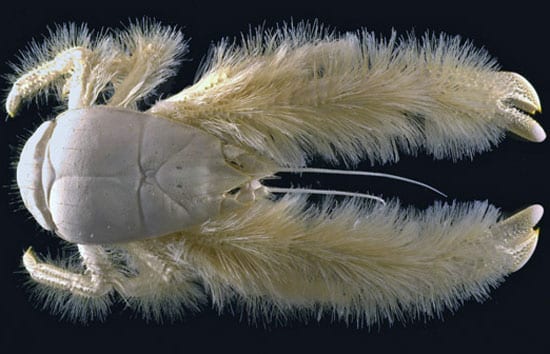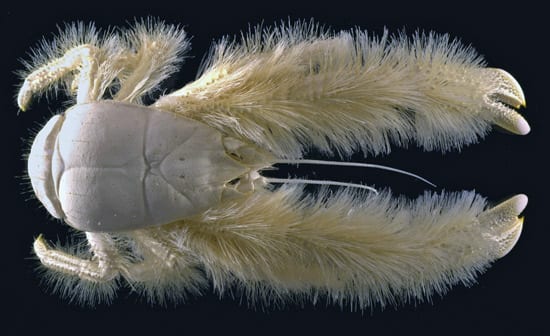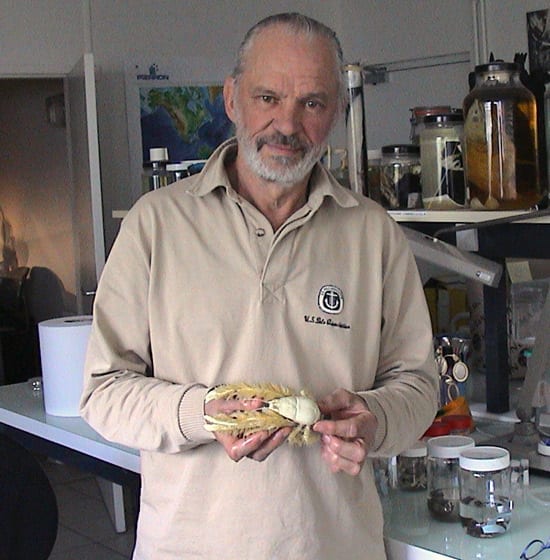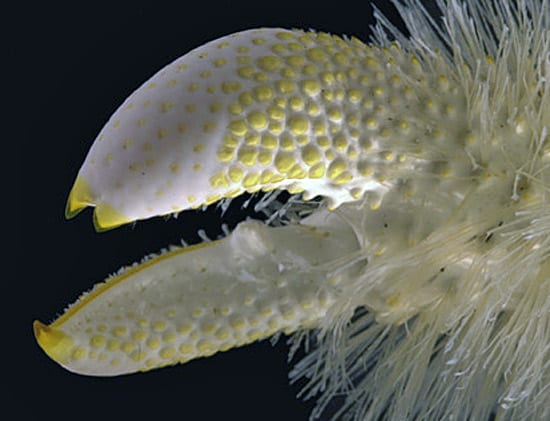
Lurking Benignly on the Seafloor, the ‘Yeti’ Crab is Discovered
The white, long-armed, shaggy creature represents an entirely new family of crabs
Biologist Cindy Van Dover routinely finds new, unusual creatures when she dives to unexplored areas of the ocean in the deep-sea submersible Alvin. So she was not particularly fazed when she and biologist Michel Segonzac spotted the white crab with long, hairy arms on the seafloor in the southeast Pacific in March 2005.
Months later, though, Van Dover became excited after Segonzac examined the crab’s morphology and found that it was not only a new species, but that it belonged to a previously unknown genus and—even higher in the hierarchy of taxonomy—to an entirely new family of crab.
“Now I think it is a superb creature and very curious,” said Van Dover, a scientist at The College of William & Mary. She’s not alone.
Segonzac and colleagues published their findings late last year in the French journal Zoosystema, and this spring the crab’s image began appearing in magazines and newspapers worldwide, from Popular Mechanics to The New York Times.
‘Perfect alien weirdness’
The name of the new family, Kiwaidae, comes from Kiwa, a Polynesian goddess of crustaceans. It’s only the second new family of deep-sea crab identified since the mid-1800s. The crab’s genus and species is Kiwa hirsuta (the latter from the Latin word for “shaggy” or “bristly”), which scientists picked after seeing the crab’s long arms, coated with yellow-tinted white hairs that feel like toothbrush bristles.
Less formally, the new-found creature has become known as the “Yeti” crab, after the legendary shaggy “snowman” of the Himalayas.
“People loved it, and I was shocked by this,” said Joe Jones, a scientist at Monterey Bay Aquarium Research Institute (MBARI) who assisted with genetics analyses. “I thought nobody would care except crustacean nerds.”
An image of the crab, displayed at a science conference in Scotland, “sent murmurs up around the room,” Jones said. One online blog by non-scientists called the crab “sublime and magical and perfect in its alien weirdness.” Another blogger posted contemporary rap music dedicated to the crab. A woman in Tokyo sent Jones a sewing pattern for crafting stuffed animal versions of the crab. The pattern, she said, has been downloaded from her web site more than 2,300 times.
“I think it’s great that people are sincerely interested in new, strange things discovered living at the bottom of the ocean,” Jones said. “It reminds us all that we have areas of the seafloor the size of Colorado and Wyoming that haven’t been explored at all.”
Bacteria and bristles
Though the crab has been compared to a lobster, Jones said it is actually a distant relative of the hermit crab.
Scientists are beginning to study the bacteria living on the crab’s hair; video footage taken during the Alvin dives shows the crabs holding their hairy claws over plumes of hot, mineral-rich fluid flowing from seafloor cracks called hydrothermal vents.
How the crab uses the bacteria remains a mystery. Researchers speculate that the crabs may house bacteria in their bristles, where the bacteria reproduce and provide a steady source of crab food. The bacteria may also serve to detoxify poisonous compounds, such as sulfur, emitted in the vent fluids. Or the bacteria may convert sulfide compounds into food in exchange for a place to live on the crab.
“We will need additional specimens of crab to establish the relationship,” Jones said.
Slurping up a crab
The crab was an unexpected find during an expedition, led by MBARI scientist Bob Vrijenhoek, to learn how seafloor-dwelling animals from one hydrothermal vent colonize other vents hundreds or thousands of miles away. On an Alvin dive, Segonzac, from Institut Français de Recherche pour l’Exploitation de la Mer (IFREMER) in France, noticed unusually large crabs lurking among seafloor rocks.
Near the end of the six-hour dive, Alvin pilot Anthony Tarantino of the Woods Hole Oceanographic Institution suctioned a 6-inch male into a sample box on Alvin using a vacuum-like hose known as the “slurp gun.”
The researchers saw more crabs during subsequent Alvin dives. Most were living at depths of about 7,200 feet (2,200 meters) on areas covered with fresh lava, or areas where warm water was seeping from the seafloor.
The study site was about 1,000 miles south of Easter Island. It was Alvin’s first trip that far south in the Pacific in its 40-year career, said Rick Chandler, a submersible operations coordinator with the Alvin group at WHOI—which might help explain why Kiwa hirsuta has never been spotted before. Future expeditions will explore the crab’s range in the South Pacific, Jones said, and scientists hope to collect several more samples to examine differences between males and females.
And the fate of the famous first crab they captured? It’s stored in a sample jar at the French National History Museum in Paris, part of its large reference collection of deep-sea crabs.
The National Science Foundation funded this research.
Slideshow

Slideshow
- The name of the new family of deep-sea crab discovered in March 2005 is Kiwaidae, which comes from Kiwa, a Polynesian goddess of crustaceans. Less formally, the newfound creature has become known as the ?Yeti? crab, after the legendary shaggy ?snowman? of the Himalayas. (Photo courtesy of Michel Segonzac, IFREMER)
- Biologist Michel Segonzac with the 6-inch Yeti crab in his lab at Institut Francais de Recherche pour l'Exploitation de la Mer (IFREMER) in France. The crab is now stored at the French National History Museum in Paris, part of its large reference collection of deep-sea crabs. (Photo by J.Y. Quintin, IFREMER)
- Scientists are beginning to study the bacteria living on the crab's bristles; video footage shows the crabs holding their hairy claws over plumes of hot, mineral-rich fluid flowing from seafloor cracks called hydrothermal vents. But how the crab uses the bacteria remains a mystery. (Photo by J.Y. Quintin, IFREMER)
Video
Related Articles
- The story of a “champion” submersible
- Robots to the Rescue
- Who is Alvin and what are sea trials?
- 7 Places and Things Alvin Can Explore Now
- The story of “Little Alvin” and the lost H-bomb
- Meet the Alvin 6500 Team: Lisa Smith
- Overhaul to take Alvin to greater extremes
- Meet the Alvin 6500 Team: Rose Wall
- Racing an undersea volcano


